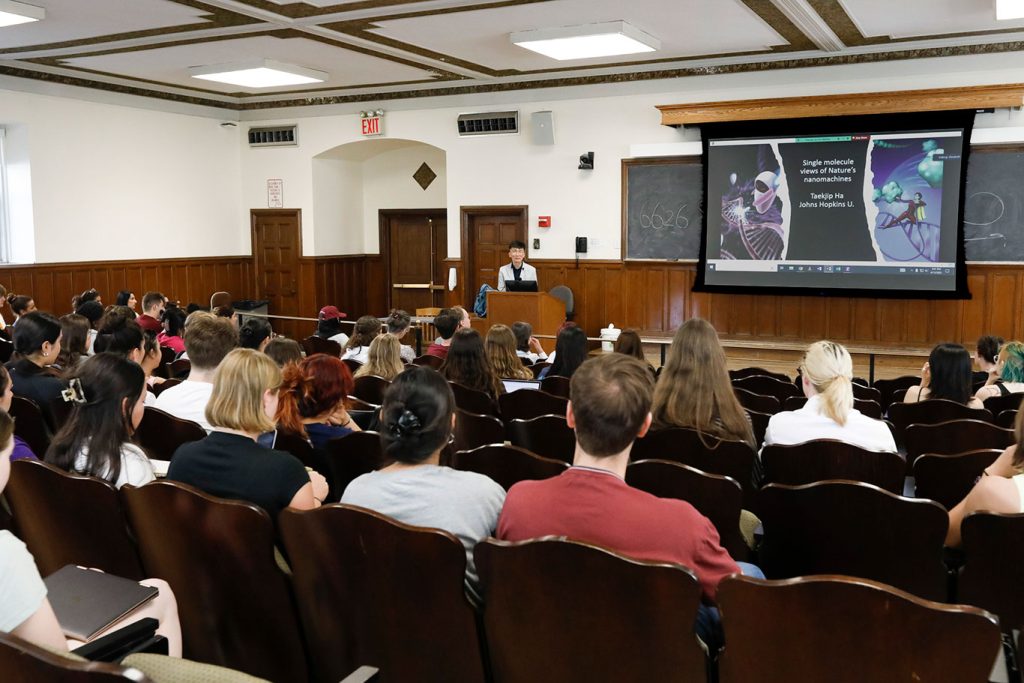Lorna Ronald, Ph.D., director of the Office of Prestigious Fellowships, said the students’ early start in the lab, as well as their close collaboration with faculty, were significant factors in receiving the award, which is granted to sophomores and juniors.
“The Goldwater Foundation is looking for students who will become our nation’s leaders in STEM research, so they’re interested in students who have already made an impact, sharing their findings at conferences and in publications,” Ronald said. “Our two Goldwater scholars started undergraduate early and have great mentors. Both Dr. Ipsita Banerjee and Dr. Nicholas Sawyer have worked closely with these students to enable them to produce national quality research as undergraduates.”
Researching Natural ‘Chemo-Targeting Devices’
Biggs’s research explores how proteins (and peptides) can be designed from natural products—or molecules that are produced by living organisms such as bacteria, fungi, fish, mollusks and plants—can be used as “tumor-targeting devices.”
“The goal is to be able to specifically target therapeutics to the tumors, so that it avoids damage to non-cancer cells, and mitigate the side effects that chemotherapy is known for,” said Biggs, a junior majoring in biochemistry.
Biggs and Banerjee grew replica multi-cellular miniature tumors as models in the lab to test their newly designed molecules and examine mechanisms of drug delivery into the tumors. This summer, she’s going to continue her work, this time with ovarian tumors and “other naturally derived cancer targeting molecules.”
“It’s just been wild to be an undergraduate and to have access to these kinds of research opportunities,” she said.
Biggs joined Banerjee’s lab her first year, after going to talk with her about declaring her major.
“She is fantastic,” Banerjee said. “She was always interested in natural product work and the applications of biochemistry and chemistry. She’s a quick learner and one thing I look for in my students is ambition and passion for research. She has the ambition, the motivation, perseverance and she’s very detail oriented.”
The Role of Shapes in Chemistry
Victorio, who will earn one bachelor’s degree in chemistry from Fordham University and a second bachelor’s degree from Columbia University in chemical engineering as a part of Fordham’s 3-2 cooperative program in engineering, was nominated for the Goldwater award through Columbia.
Sawyer said that he and the students in his lab work on developing peptides—short chains of amino acids—that act as treatments and gain access to the cell’s interior.
“What Clara set out to do is help us, as a scientific community, develop a fundamental understanding of how shape plays a role in how peptides enter cells,” he said.
Victorio’s work included an accidental discovery: She set out to take a peptide that had one shape and turn it into a second type of shape, but her work showed that it can actually make a third shape as well.
“It’s really rewarding when a reaction works as expected, because it doesn’t always do that,” she said with a smile. “But, some of the results of the reactions were surprising, and they spun into these whole new avenues.”
Sawyer said that Victorio’s work is at the center of a collaboration with colleagues from the University of Missouri, where they’re continuing to study “where this third shape comes from, and what the factors are that contributed to making that happen.”
]]>After graduating from Fordham College at Rose Hill in 2022 with a degree in integrative neuroscience, Diego Perez landed a spot in the Harvard Stem Cell Institute’s Camargo Lab, which focuses on adult stem cell biology, organ size regulation, and cancer.
As a research assistant, one of the main things he’s working on is lineage tracing, which allows researchers to follow individual cells to better understand biological processes. He’s been using cellular barcoding, a technique that allows researchers to label and track individual cells, to study blood development in cells.
“A lot of the research I’ve done here has informed my next steps,” says Perez, who is applying to M.D.-Ph.D. programs. “I really fell in love with all the lineage-tracing work.”
Using Philosophy in Science
Perez says conducting research with Ipsita Banerjee, Ph.D., chair of the Fordham chemistry department, and publishing their work in academic journals, set him up well for his current role at Harvard. One of his Fordham projects involved the use of 3D bioprinting to try to inspire nerve growth and help people with spinal cord injuries.
He says that he was always interested in neuroscience, even when he was a student in high school in Florida, which is part of why he chose Fordham. “I went to a couple of summer camps that really solidified that, and now I think I’m going into anti-aging and longevity research—I think that’s going to be one of my passions as I move through.”
Perez also feels he benefited from the interdisciplinary training he received at Fordham, where he minored in both biochemistry and philosophy.
“I took a scientific realism course, and now, when I’m talking to my advisor here, we’ll ask questions like, ‘Is this picture of what we’re seeing true? Is it useful? Is it just a data error?’ All of this, at the end of the day, is philosophy,” he says with a laugh. “I’m doing that philosophy, I’m doing the computational work, and it’s all such a blend.”
From Swimming to Tightrope Walking
At Fordham, Perez also was a Division I athlete on the diving team, where he took home first place in the one-meter dive his senior year. One of his standout memories from Fordham was a summer training trip to China with his diving coach.
“It was one of the greatest experiences I got to have at Fordham,” he says. “I got to train with the Olympic national team there.”
He says he still draws on his athletic training, even if he’s no longer competing.
“Health and fitness is pivotal for my mental work,” he says. “I’m still trying to incorporate a lot of acrobatics. I’ve taken up tightrope walking, and we also do highlining with a harness. I find stuff like that to be essential to keep me sane.”
Perez says that after his graduate programs are finished, he wants to continue working in research.
“I want to become head of my own lab, doing some sort of clinical research, maybe working with a biotech startup that can help me move forward with this field of regenerative research,” he says.
Read more “20 in Their 20s” profiles.
]]>With help from recent graduate Beatriz Goncalves, FCRH ’23, and her mentor Professor Ipsita Banerjee, Ph.D., Phan looked into how specific peptides—strings of amino acids—could potentially mitigate an enzyme that contributes to ALS from “misfolding,” or failing to function properly.
The goal of the project was to design new peptide-based drug molecules on a nanoscale level that would limit that misfolding so that it wouldn’t disrupt the other proteins from working properly within and outside the cells, according to Goncalves and Banerjee. Goncalves and Phan showed that the molecules that they developed were able to reduce oxidative stress in cells, and that some of the molecules could mitigate misfolding over time.
“The results have been exciting,” Goncalves said.
Phan and Goncalves were just two of the students who spent the summer conducting research in Banerjee’s lab in John Mulcahy Hall at Rose Hill.
Banerjee, the chair of the chemistry department and program director of Biochemistry, said her students have been working on drug delivery systems, particularly those that target tumors and cancerous cells, and developing new biomaterials for tissue engineering as well as targeting protein misfolding in neurodegenerative diseases.
In the lab, the students have access to a variety of scientific equipment, such as a 3D bioprinter, which allows them to replicate tissue growth and investigate these tissue models for their research.
“My biggest passion at Fordham is working with students in the research lab, and preparing them to become next-generation scientists,” Banerjee said, adding that she mentors students throughout the year, both in the lab and in her classes.
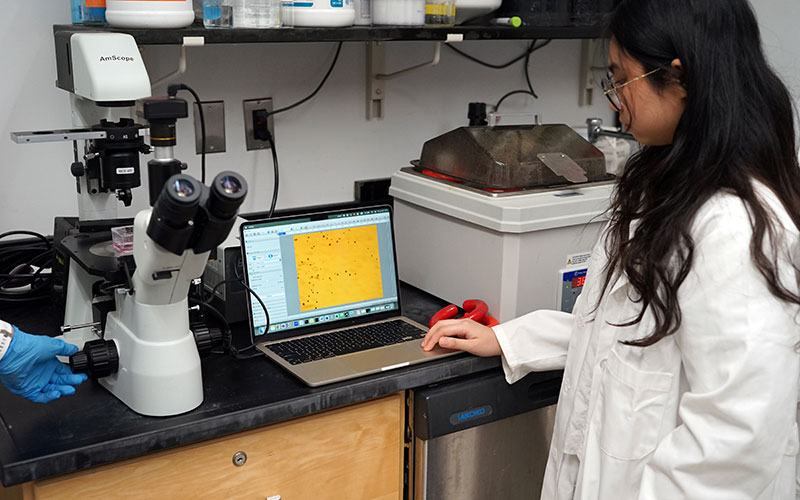
From the Lab to a Ph.D.
For Goncalves, who was a biology major and biochemistry minor, the experience in Banerjee’s lab helped her get accepted into numerous Ph.D. programs. She chose to pursue her Ph.D. at the University of Pennsylvania, going for cell and molecular biology where she will work on immunotherapeutic research for targeting cancer.
“I’m an undergraduate student who had the experience and who has the resume to be able to go straight into a Ph.D. That’s an opportunity that was offered to me at Fordham that I probably would not have had at other schools,” she said. “I would probably have to take a gap year or do something else like a master’s in order to have the resumé I have now.”
Goncalves published at least five research papers with Banerjee at Fordham, including a few where she was the first author on the project. She and Molly Murray, FCRH ’23, who majored in chemistry and psychology, said that they spent 10-12 hour days in the lab in summer 2022 and during the school year working on a variety of projects, such as developing ways to deliver drugs into glioblastoma tumor cells as well as developing new peptide based drug molecules for targeting breast tumor cells. The pair also spent this past summer in the lab wrapping up their research projects.
“Beatriz and I last summer, we probably spent about 80 hours a week here,” Murray said. “There were a lot of times where we were here past midnight, but I feel like we’re both very well prepared for going into Ph.D. [programs] and that kind of time commitment.”
Murray, who was also accepted to several programs and will start a Ph.D. in chemistry at the University of North Carolina next fall, said that before working in Banerjee’s lab she had minimal lab experience.
“I think she definitely challenges us a lot—especially when you’re first coming into the lab, there’s a ton of stuff to learn right off the bat,” she said. “We’re a lab that helps each other out a lot, but there’s also that part of it that you have to investigate by yourself, so having that push is definitely helpful.”
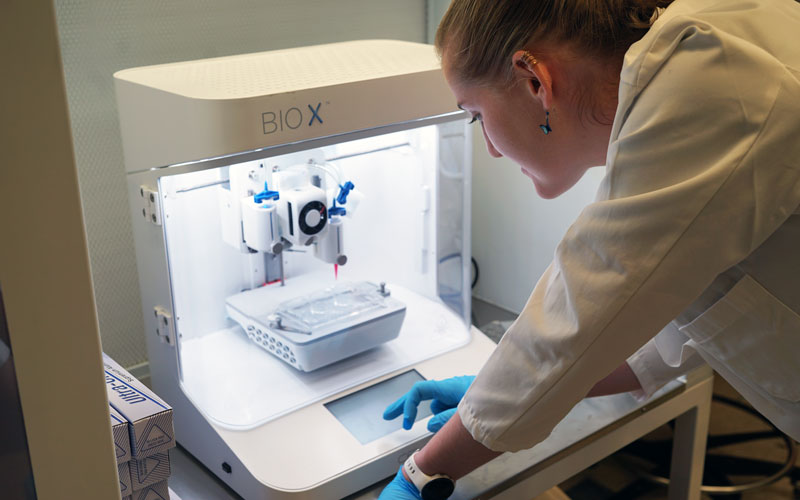
Research on Cancer, Aging, and More
Many students working in the lab over the summer were focusing on drug or treatment delivery systems that could target cancer cells. Murray focused on ovarian cancer, while Amrita Das, a sophomore biology major, started a research project investigating lung cancer.
“I plan on going to med school,” Das said, “so I wanted to get exposed to a research lab setting to get experience.”
Sophomore Aigerim Mukhit’s summer research focused on skin regeneration and aging, particularly around cells called fibroblasts.
The goal of her research was to investigate the impact of peptide conjugates on aged fibroblasts to examine if they enhance can express characteristic proteins, which are indicative of regeneration.
“I just want to contribute to biomedical research—I want to study aging, not only skin aging, but overall aging,” she said.
]]>“Our body essentially is like a laboratory—you have chemical reactions going on 24/7,” said Ipsita Banerjee, Ph.D., chair of the chemistry department and professor of chemistry. “Biochemistry is essentially a study of what reactions are going on in your body; how do we actually stay alive?”
Banerjee said that after she became chair of the chemistry department in 2018, she and a team of faculty members from the biology and chemistry departments worked to develop the minor in biochemistry, which was launched in 2020.
After the COVID-19 pandemic, she worked on developing the major with a team of chemistry faculty members, who developed new courses for the Biochemistry major. The major was approved by the New York State Department of Education this summer.
The major will be open to all students starting this fall. For now, incoming first-year students who are interested in the major will come in as undeclared, though they can still begin to take classes toward it. Beginning next fall, first-year students will be able to enter as biochemistry majors.
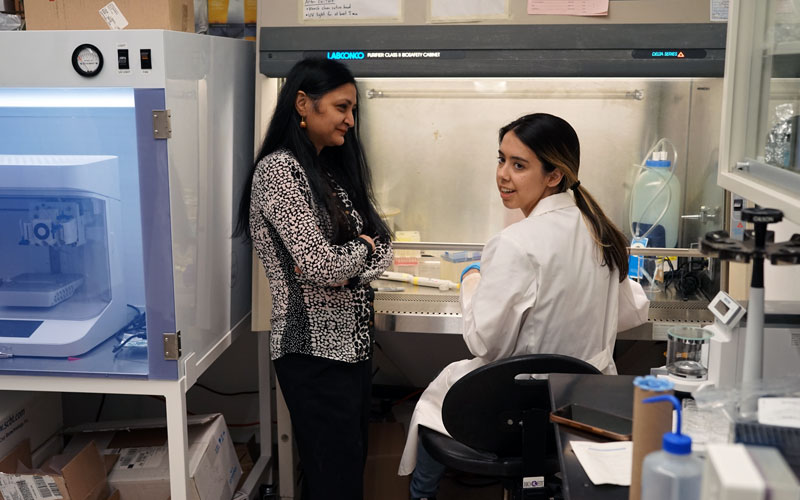
Preparation for Biotech, Medical Industries
Banerjee said that biochemistry studies will help prepare students for the expanding biotech industry, which has seen massive growth post-COVID.
“There are so many diseases today that we still don’t have a cure for—Parkinson’s, Alzheimer’s, cancer, to name a few,” she said. “While there has been progress made, much more needs to be done to understand how these diseases work, you really have to understand how things work at the molecular level—that’s what biochemistry does.”
Banerjee said that the degree will also help prepare students for graduate and medical school as well as careers in areas such as biochemistry, forensic science, pharmacology, biomedical engineering, biomedical sciences, and other health-related fields.
She noted that there’s been a real interest from students in this type of major.
“Many of the STEM students are interested in a career in medicine, allied health fields, or health professions, so biochemistry essentially ties into that,” Banerjee said.
Hands-On Learning in Biochemistry
The major has an interdisciplinary focus, according to Banerjee, as it integrates lessons from both biology and chemistry and adds new courses to broaden students’ exposure to the subject. This allows students to “approach it in a way that is interesting to [them].”
There are two tracks within the major—an American Chemical Society (ACS) certified track and a general track. Students who are interested in chemistry and advanced structural and molecular aspects of biochemistry may choose the ACS track, while students who are inclined more toward cell, molecular, and structural aspects of biochemistry and physiological approaches may pursue the general track.
Students will start by taking introductory STEM courses in biology, chemistry, physics, and calculus to lay the foundation for their work, she said.
“The upper-level courses are where they can really start immersing themselves,” she said. Those include Molecular Biology, Physical and Computational Models of Biochemical Systems, Biochemistry I and II, Methods of Biochemical Research, and more.
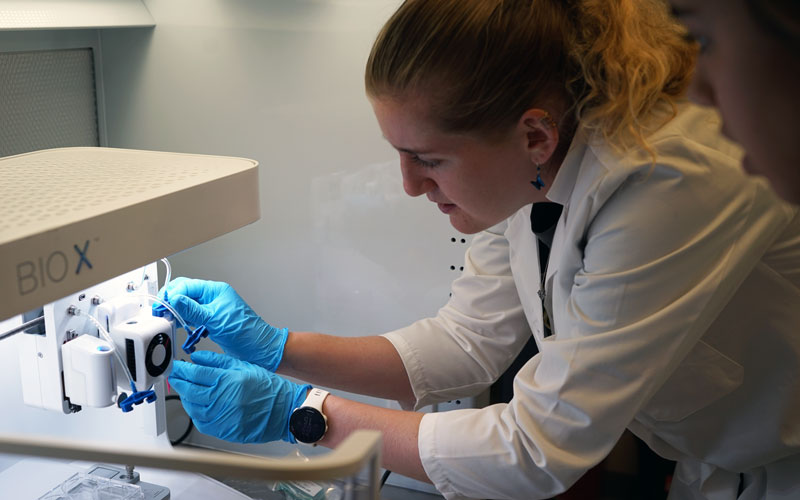
Research Opportunities
Biochemistry majors can also work to join research laboratories, such as Banerjee’s and those of other faculty members who are doing chemical biology, biophysical, and cell and molecular biology-related research.
This gives students opportunities to gain hands-on experience and potentially publish their work in peer-reviewed scientific journals, Banerjee said, as students will be engaged in challenging research projects and feel an ownership toward their projects.
“My biggest passion at Fordham is working with students in the research lab, and preparing them to become next-generation scientists,” Banerjee said. “Research is a big part of our department as a whole, so students will have ample opportunities to do research with the mentor of their choice.”
STEM Partnerships in NYC
Banerjee said that she believes this major will help elevate the University’s connections to growing STEM industries.
“I think one of the things we’re really trying to do, given the location of Fordham being in New York, is expand into the biotech industry, have partnerships with the larger community within New York as well as the suburbs, Westchester, all those areas,” she said. “I think by having this biochemistry major it will also provide, in addition to working with faculty mentors here, internship opportunities for students.”
]]>In October, the department won the Jean Dreyfus Lectureship Award, a highly competitive award from the Dreyfus Foundation that was only given to seven universities in the United States this year.
Hosting Lectures on CRISPR, DNA Repair, and Proteins
The award enables the department to host a lecturer of their choosing. Fordham proposed Taekjip Ha, Ph.D., a Bloomberg Distinguished Professor of Biophysics and Biophysical Chemistry at Johns Hopkins University School of Medicine.
Ha, who has done pioneering research in the field of single-molecule fluorescence spectroscopy and is a leader in the field of CRISPR technology, delivered two lectures at the Rose Hill campus on April 12 and 13. One, titled “Light, CRISPR and DNA Repair” was geared toward the scientific community, while the other, “Single Molecule Views of Nature’s Nanomachines” was crafted for the general public. The latter focused on how biophysicists are using light-based tools to examine proteins—nature’s nanomachines—one molecule at a time.
The criterion for the award was based partly on the department’s efforts in scholarly research and education in the contemporary chemical sciences, as well as information about the number of chemistry majors at the institution and how many go on to graduate school.
The principal investigator responsible for assembling the information was Elizabeth Thrall, Ph.D., assistant professor of physical/biophysical chemistry. Ipsita A. Banerjee, Ph.D., professor and chair of the department, and Joshua Shrier, Ph.D., the Kim B. and Stephen E. Bepler Chair Professor of Chemistry, were co-investigators for the award, which also provides funding for two students to conduct research this summer.
Schrier and Thrall were also awarded, along with Yijun Zhao, Ph.D., an assistant professor of computer and information science, Fordham’s inaugural James C. McGroddy Award for Innovation in Education.
The team, which will share a $10,000 prize, was honored for path-breaking interdisciplinary work that has transformed lab courses in chemistry by incorporating data science and machine learning into the undergraduate curriculum.
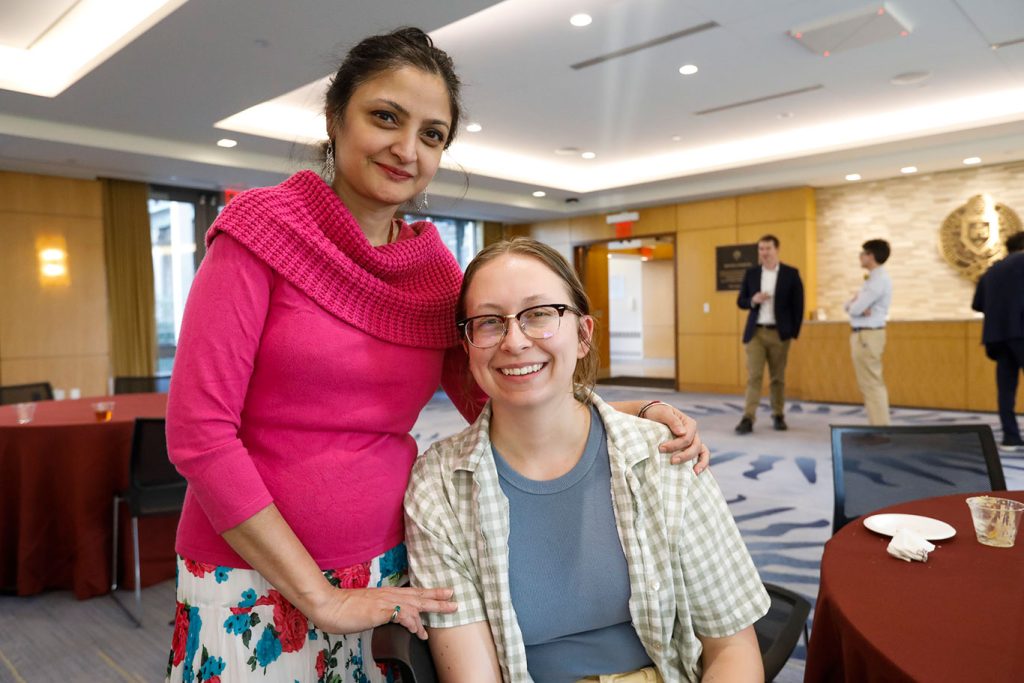
Biochemistry Professor Honored with Three Awards
Banerjee, who became chair in 2018 and whose research involves harnessing bionanotechnology to tackle cancer and other illnesses, attributed the Dreyfus award to the strengths of the department, which in recent years has added faculty, won highly competitive grants such as those from the National Science Foundation, and is in the process of adding a biochemistry major.
She said the win also reflects the department’s choice of Dr. Ha. Ha, who spent time after his lecture chatting with STEM students at a reception, clearly impressed the judges, she said.
In addition to the Dreyfus award, Banerjee was also individually honored this year with three awards. She received the Middle Atlantic Region American Chemical Society’s 2023 E. Emmet Reid Award in Chemistry Teaching at Small Colleges, the Distinguished Scientist Award from the Westchester Chemical Society, and Fordham’s Distinguished Research Award in the Sciences and Mathematics.
“I’m very honored, but at the same time, it also makes me want to work harder and try to do more for our students, particularly when it comes to research,” she said.
“Research is my passion, and working with students is what I love.”
]]>
“Ray was consistently demanding but incredibly patient,” Doyle said of Father Schroth, a Jesuit priest, professor, and journalist who died in July 2020 at the age of 86.
A 1955 graduate of Fordham College at Rose Hill, Father Schroth was an associate professor in the communications department at the University from 1969 to 1979 and served for several years during the 1990s as an associate dean of Fordham College at Rose Hill. Throughout his career, he was a mentor to dozens of students who became lifelong friends, including Pulitzer Prize-winning reporters Loretta Tofani, FCRH ’75, and Jim Dwyer, FCRH ’79.
At the memorial service, Doyle shared something Father Schroth wrote about one of his own Fordham professors, someone who had “loomed large as a Catholic intellectual 30 years before.”
“Ray wrote that he knew that ‘inside that handsome gray head and behind that gentle, courtly manner was a flame lit from the first torch ever lit and passed along at Fordham. I knew I should experience it before it flickered out.’”
Countless Fordham students and alumni have beheld that flame through the years and not only kept it from flickering out but taken up the torch and shared their own spark of light with others.
Take, for example, Bill Kiernan, a Long Island brewery owner and AP English teacher. He recently drew on two courses he took with Fordham professor Mark L. Chapman 20 years ago—the Black Prison Experience and the Black Church—to help his own students understand and join national conversations on racial justice following the killing of George Floyd.
Or consider neurochemist Nako Nakatsuka, a 2012 Fordham grad recently named one of MIT Technology Review’s “35 Innovators Under 35.” As an undergraduate, she formed a tight bond with chemistry professor Ipsita Banerjee, collaborating with her on research, motivated by a shared hunger for learning and scientific discovery.
“She was my scientific savior at a time when I was pretty lost and didn’t know how to focus my energy,” Nakatsuka said of Banerjee. “She really put in a lot of time and effort in developing my potential as a scientist.”
The Fordham family is full of such stories. Share yours with us at [email protected].
]]>From remembering song lyrics to pouring a cup of coffee, every impulse in the brain starts on a tiny scale, with an electrical signal firing between brain cells across a synapse only 50 nanometers wide—2,000 times thinner than a sheet of paper. That signal directs the flow of brain chemicals such as serotonin, norepinephrine, and dopamine, which trigger the next electrical signal, and so on.
Physicians use sophisticated tools, such as electroencephalograms, or EEGs, to diagnose and monitor brain disorders, but they see only the electrical impulses, which is a bit like hearing two people talking but not understanding what they are saying, says Nako Nakatsuka, Ph.D., a chemist at ETH Zürich in Switzerland. “It’s like a very muffled conversation.”
Scientists have struggled to identify those complex chemical interactions at the time they occur. Often, that requires extracting liquid from the brain and putting it through tedious purification techniques in the lab, a process that can take days.
“I wanted to be able to insert a sensor close to where these interactions happen and monitor this chemical flux in real time,” says Nakatsuka, a 2012 Fordham College at Rose Hill graduate who has spent the past several years developing a chemical biosensor to do just that. The technology she created consists of a glass pipette tapering to just 10 nanometers at its tip, able to get in close proximity to synapses and monitor chemicals at the source. “We’re using nanotechnology to approach the dimensions at which the chemistry happens,” Nakatsuka says.
The invention earned her a spot this year on MIT Technology Review’s list of “35 Innovators Under 35” (out of over 500 nominations). More importantly, it could revolutionize the study of diseases such as Alzheimer’s and Parkinson’s by allowing neuroscientists to truly understand, for the first time, chemical interactions inside the brain as they occur.
Into the World of Bionanotechnology
Nakatsuka spent her formative years attending an all-girls school in Japan, where she was just as interested in art and athletics as she was in science.
“I was able to grow into myself and be confident in the things I liked and pursued without issues such as body image or imposter syndrome,” she says. “No one ever told me, ‘You can’t do that because you are a girl.’” Inspired by hands-on chemistry experiments in high school, she decided to pursue the subject at Fordham, where she also ran competitively on the cross country and track and field team.
An unexpected connection between sports and science led to her interest in nanotechnology. She was taking a course in organic chemistry, and professor Ipsita Banerjee, Ph.D., was her lab instructor. “I was ranting to her about how I had no idea how this stuff was applicable to real life,” remembers Nakatsuka, who at the time had torn a ligament and tendon in her ankle while running, and was on crutches and wearing a walking boot. Banerjee told her about her research in tissue engineering. “She said, ‘Imagine if you could heal yourself by using biocomposites you created in a lab that could mimic the tissue in your body, rather than getting surgery and being out of commission for a year.’”
Nakatsuka was fascinated by the idea. She joined Banerjee’s lab the following fall and plunged into the world of bionanotechnology, a highly interdisciplinary field focused on developing biomolecular composites for biomedical applications in tissue engineering, biosensors, and drug delivery. “She was my scientific savior at a time when I was pretty lost and didn’t know how to focus my energy,” Nakatsuka says. “She really put in a lot of time and effort in developing my potential as a scientist.”
At the time, Fordham lacked much of the equipment necessary for Banerjee’s nanotechnology research, so she would drive her students to Queens College, part of the City University of New York, where a colleague allowed them to use the equipment in his lab. Initially, Banerjee was worried that Nakatsuka’s sports schedule would keep her from the necessary work. Instead, she found her to be an incredibly dedicated researcher. “It didn’t matter if she had exams, or had a meet somewhere, I could rely on her,” Banerjee says. The two developed a tight bond, with the professor sometimes dropping Nakatsuka back at her dorm at 3 a.m. after a night of experiments in the lab and animated conversations about science over breakfast at an all-night diner.
“Since we don’t have a graduate program, I expect graduate-level work from my research students,” Banerjee says. Nakatsuka rose to the challenge, becoming lead author on a review paper on tissue engineering, and co-authoring seven other peer-reviewed papers with Banerjee during her time at Fordham.
Catching the Brain’s Chemical Signals
While presenting one of their papers at an American Chemical Society national meeting in San Diego, Banerjee and Nakatsuka met with Paul Weiss, Ph.D., a UCLA professor and nanotechnology pioneer whose research group combines science, engineering, and medicine. The ability to make a practical difference appealed to Nakatsuka, who joined Weiss’ group as a doctoral candidate after graduating from Fordham.
“It fascinated me to think about using chemistry and biology to do something I was passionate about, and contribute to society,” she says. While there, she began working with aptamers, short single strands of DNA that are specifically designed to attach themselves onto a chemical target.
Nakatsuka was intrigued by the ability these aptamers have to change their shape when latching onto their prey. “It is like when the fingers of a baseball glove come down to capture a ball,” she explains. “They structure switch.”
Nakatsuka began using that property to create a sensor that could detect the presence of a specific chemical in the body. Existing biosensors have struggled to differentiate similar molecules from one another accurately, especially when the desired chemical is in short supply.
“It’s like trying to find and capture one fish in a sea of similar-looking fish that exist in much higher amounts,” Nakatsuka says. Collaborating with nanoscientists and engineers, she created an ingenious probe with a tiny pore at one end that was covered in aptamers designed to capture a specific neurochemical such as serotonin, along with several electrodes. When serotonin was present, the aptamers would switch their structure to make the nanoscale opening more porous, and alter the electrical flow that could be measured by scientists in real time. By calibrating the sensor in advance, they could even tell how much serotonin was present in a given sample.
Toward a Better Understanding of Brain and Body Health
After designing the sensor and earning a Ph.D. at UCLA, Nakatsuka moved to ETH Zürich, a scientific institute with a specialized Laboratory of Biosensors and Bioelectronics, for a postdoctoral fellowship in 2018. She’s now a senior scientist there, working with a team of neuroscientists to train the sensors to detect neurochemicals that could provide new insights into Alzheimer’s and Parkinson’s, for example, by quantifying neurochemicals in the brain and blood associated with those diseases.
“What’s exciting to me is that there are neuroscience groups that have been focused on one question for a long time—for example, understanding how dopamine is regulated in brain development, or how serotonin is regulated in anxiety and depression,” Nakatsuka says. By distributing her kits to these scientists, she says, she can provide new tools to generate data and answer some of those questions in a much quicker and easier way.
While Nakatsuka’s sensors are currently being used only in the laboratory, she hopes that eventually they could be used in the body, inserted like an acupuncture needle to monitor brain chemistry in patients. They could have applications beyond neuroscience, as well, providing an ability to detect chemicals anywhere in the body—for example, monitoring iron in anemic patients or stress biomarkers for people with anxiety disorders. She envisions people wearing a Band-Aid-like device with the nanopores integrated inside that could withdraw small amounts of blood with a tiny needle to provide ongoing monitoring. “That’s more of an engineering challenge,” she says. “But it’s really not crazy to imagine implementing it in a way that is practical and applicable for daily use.”
From such tiny beginnings, Nakatsuka’s nanosensors have big potential, giving scientists new ways to understand and monitor diseases throughout the body. “Now I often hear, ‘Are you going to commercialize this? When are you going to go on the market?’” she says. “To be honest, I never thought about it, but now it’s something I want to start looking into to see how I might make a larger impact.”
—Michael Blanding is a journalist and the author of three books, including North by Shakespeare: A Rogue Scholar’s Quest for the Truth Behind the Bard’s Work (Hachette, 2021).
]]>Chemistry Department Chair Ipsita Banerjee, Ph.D., said the addition of these two scientists will expand not only the department’s ability to provide specialized research opportunities to students, but also the scientific community’s knowledge of important areas like solar energy and genetic diseases.
“Dr. Schneider’s field of research is in the area of design and synthesis of novel organic semiconductors for building devices such as solar cells,” said Banerjee. “Dr. Thrall’s research may further advance our understanding of the mechanistic processes involved in diseases like cancer and provide more information about how a lack of proper DNA repair mechanisms are involved in genetic disorders.”
In time, these are things that Fordham undergraduates will learn, too.
“The types of research that we’re doing—the techniques we’re using and the problems we’re investigating—are really cutting edge. These are things that are getting done at top graduate schools across the country,” said Thrall, a two-time Ivy League graduate. “These are approaches that [our] undergraduates can learn.”
A Long Line of Chemists
Thrall is an assistant professor of chemistry who started teaching at the Rose Hill campus this September. A Philadelphia native, she comes from a family of chemists. Her grandparents, especially her grandmother Jean Simmons who earned a Ph.D. in chemistry from the University of Chicago in the late 1930s and taught at women’s colleges, inspired her to become a chemist. Her other inspiration was the science itself.
“Not to sound cheesy, but chemistry is the central science; it extends into biology and physics,” she said. “I’ve always enjoyed the breadth of topics you can explore as a chemist.”
Her lab at Fordham specializes in single-molecule biophysics: a field that explores how biological systems function by analyzing the behavior of biological molecules, one at a time. The goal is to understand how DNA replication and repair work.
“It’s remarkable that we can look inside a living bacterial cell and see a single molecule moving around. If you watch the movies that we record in my lab, you’ll see a single spot of light bouncing around rapidly in this small cell. That’s a single protein in the cell,” said Thrall, who has published work in several publications, including Nature Communications.
Thrall served as a National Institutes of Health National Research Service Award postdoctoral research fellow at Harvard Medical School for six years. She earned a bachelor’s degree in chemistry and physics from Harvard University and a Ph.D. in chemical physics from Columbia University.
This semester, she is teaching a physical chemistry lab for juniors and seniors; next spring, she plans on teaching a lab course and a physical chemistry lecture. Two undergraduate student researchers recently joined her lab.
A Pastry Chef Turned Chemist
Schneider is an assistant professor of chemistry who joined the Fordham faculty last fall. She was born in Paris, France, to a French mother and an American father. What drew her to chemistry was the ability to create something new—something that no one has seen before.
“Every new molecule, every new structure can have new properties,” Schneider said. “There’s a ton to discover.”
She said chemistry reminds her of her days as a pastry chef in Boston, where she concocted chocolate lava cakes, handcrafted ice cream, and Boston cream pies on a daily basis.
“It’s nice making something, and then someone eats it at the end of the day. You served a purpose,” she said. “[Similarly,] I love organic chemistry because you get to make something.”
She earned a bachelor’s degree in chemistry from Southern Connecticut State University and a Ph.D. in chemistry from McGill University, where she was a Vanier Scholar. From 2016 to 2018, she served as a postdoctoral researcher at the University of California, Santa Barbara, where she collaborated with visiting researchers as part of the Mitsubishi Chemical Center for Advanced Materials.
At Fordham, she teaches organic chemistry I and II labs to sophomore students, who learn how to identify, purify, and separate different compounds. Last summer, she mentored her first three undergraduates through University research grants. They began by setting up her new research lab and then started on the synthesis of a new organic semiconductor. This fall, Schneider and those three students—her new lab mentees—will continue to tackle that project.
Schneider’s lab specializes in organic electronics. She has extensive experience in solar cells and transistors, but she now works on illuminating the structure-property relationships that drive these devices.
“Through organic synthesis techniques, we can make materials with any properties we want. So if we want something to make a solar cell, we can design it to absorb light and give us electrons. If we want something to emit light, like an OLED [organic light-emitting diode]on your phone, we can design a molecule that makes that color,” she explained.
Not all the materials may work, but they will teach us more about the behavior of organic semiconductors.
“As we discover new properties, maybe that particular molecule won’t be super useful right away,” said Schneider, “but who knows what application it may have in the future.”
]]>A medical writer breaks down complex research to help advance cures
While earning his doctorate in chemistry, studying the finer points of cell division, Evan Smoak made a discovery that had nothing to do with centromeres or proteins or germ lines.
What he discovered was that he loved communicating science. His favorite task was translating jargon into simple narratives that engage an audience and move scientific discussions forward. And it was this realization that brought him to his current job at the crux of research into cancers and rare blood diseases.
Working as a medical writer for a medical consultancy group in Philadelphia, he develops scripts, presentations, and other materials that provide a common vocabulary for everyone involved in creating treatments—from the research lab to the doctor’s office and beyond. His work might help medical thought leaders understand the results of clinical trials, for instance, or help scientists and doctors discuss the feasibility of turning a particular lab result into a treatment, he says.
It’s the kind of work that will grow more important in light of new anti-cancer initiatives like the Beau Biden Cancer Moonshot announced in 2016 by the Obama administration. “As the science becomes more complex and more far-reaching, I think that it’s more and more important to be able to facilitate this kind of dialogue” so that the most promising research avenues get attention, he says.
Before earning his doctorate at the University of Pennsylvania, he co-authored seven articles in scientific journals as a Fordham undergraduate, helped by Fordham grants that allowed him to pursue summer research. He was mentored by chemistry professor Ipsita Banerjee, Ph.D., whose guidance, he says, “was about so much more than just the science; it was about how can you effectively communicate what you’re doing.”
He would eventually like to find creative ways to communicate science clearly to the public.
“We do have a responsibility,” he says, “to be more cogent in the way we put together our science for a nonscientific audience.”
]]>Working with chemistry professor Ipsita Banerjee, PhD, Fordham undergraduates are learning how 3D printers can be used to make replacement organs for people afflicted with osteoarthritis, cancer, or other conditions.
Along the way, they’re also learning what it’s like to be a research scientist: the long hours in the lab, the painstaking analysis, the late nights spent poring over data—and the joys of digging into fascinating scientific questions.
“I wouldn’t look at it as necessarily work,” said biology major Steve Romanelli.
That’s a typical outlook among students who work with Banerjee, whose one-on-one attention and high expectations often propel students into careers of scientific inquiry.
“Basically, I train them as scientists” by offering graduate-level tutelage, which leads many of them to fall in love with research and pursue it at universities like Oxford, Cambridge, and UCLA upon graduating, she said.
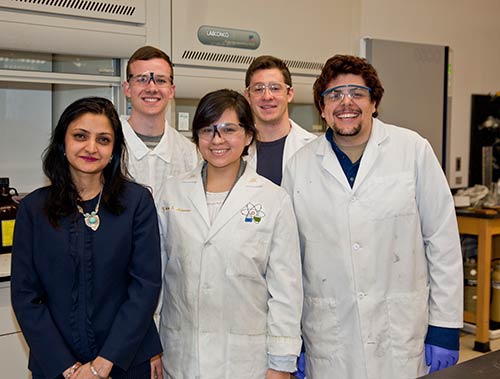
It helps, of course, to have engrossing subjects to explore. People have used 3D printing to turn three-dimensional digital images into all kinds of objects, ranging from food to firearms, and according to Banerjee it’s revolutionizing the field of tissue regeneration.
Instead of examining cells two-dimensionally, under glass on a microscope, scientists can use 3D printers to create tiny models, or scaffolds, in the shape of an organ. By filling these scaffolds with cells, they get a clearer idea of how the cells function when they’re bunched together in the organ itself.
This knowledge can then be used to fashion small replicas of organs and tissues that, when implanted, grow to their full size naturally, just as the original ones did, Banerjee said. The patient’s own cells can be used so the body’s immune system isn’t triggered, and the scaffold biodegrades as the organ grows.
But more research is needed before this technique can be used widely, and inexpensively, with minimal side effects, Banerjee said.
Her team concentrates on regenerating bone tissue and cartilage, but also skin tissue and the cornea. Banerjee’s students work on synthesizing the scaffolds and making sure they have the right properties.
Made from proteins, minerals, collagen, or other materials, depending on the type of organ being studied, the scaffolds have to be precisely designed at the nanoscale. If the composition isn’t right they might disintegrate too quickly, soak up water, attract bacteria, or trip the body’s immune defenses.
Getting the shape right is also important, especially for a cornea scaffold, which has to have the correct refractive index. Also, of course, it has to be transparent.
“That’s a very interesting challenge, but it’s fun also,” Banerjee said. “All of these are equally challenging, but each one has its own nuances that you can work with.”
Over the years, many of Banerjee’s students—Romanelli included—have been published in professional journals and presented their research at professional conferences, where they’re often the only undergraduates on the program. Their conference presentations have won several awards.
Banerjee has seen many pre-med students change their plans and pursue research instead after learning what it’s like. Romanelli, for instance, wanted to be an orthopedic surgeon when he started working with Banerjee in his sophomore year. But now, as he prepares to begin senior year, he hopes to eventually earn a doctorate in biomedical engineering instead.
Coming to the lab is “kind of a stress relief, almost,” he said. In Banerjee’s words, “It becomes a part of who you are, after a point. With them, it’s like, ‘This is what we do.’”
]]>